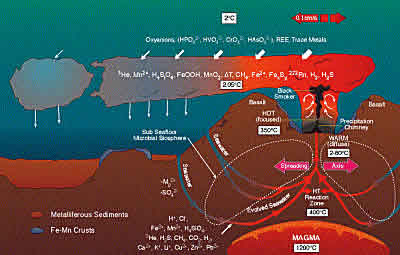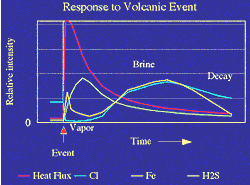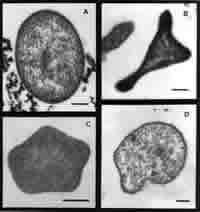| . | Why study hydrothermal plumes? |
| . |
Hydrothermal fluids mix rapidly with seawater. Entrainment of ambient seawater dilutes the rising plume and causes temperatures and particle concentrations within the plume to decrease within a short distance from a vent orifice. Hydrothermal plumes continue to rise through seawater as long as plume fluids are less dense (more buoyant) than the surrounding seawater. Once the density of the hydrothermal plume matches the density of the ambient seawater, the hydrothermal plume stops rising and begins to disperse laterally. This "neutrally buoyant plume" gets distributed by being "blown" by ocean currents at that density level. The greatest change in intensity of heat or particles within the plume occurs relatively near the source (within a few kilometers). Throughout the processes of rising, mixing with ambient seawater and subsequent advection away from the area of the source, the plume undergoes changes. The evolution of vent fluids and particles can only be studied by finding the plume and sampling it at various times and distances from the sources. Hydrothermal activity does not occur everywhere along mid-ocean ridge systems. Detecting hydrothermal plumes by measuring the intensity of temperature and particle anomalies and mapping their distributions has been an effective method for discovering the locations of major vent fields and identifying locations for further exploration.
The worldwide ocean environment is impacted by fluxes of heat and chemicals from hydrothermal vents and the subsequent transport of these properties. Locating and mapping the distribution of hydrothermal plumes within near to mid-field distances from venting sources assists the geochemists optimize their efforts to study the evolution of dissolved and particulate components of vent emissions by helping them determine the best locations and depths to take water samples. Studying the distribution of plume tracers in the far field ocean has led to new insights in understanding patterns of circulation and mixing of the deep and intermediate waters of the Pacific Ocean. A major focus of the NOAA EOI Program, especially since the discovery of a "megaplume" in 1986, has been to monitor the mid-ocean ridges off the west coast of the United States for seismic activity that could signal a volcanic eruption in progress.
In addition to the 1986 event discovered by virtue of its event plume, there were three additional events between 1986 and 1998 that were detected first acoustically, then sampled during rapid response cruises and other regularly scheduled field work. Event plumes, as megaplumes came to be called, are literally the smoking guns of seafloor spreading events. Finding these event plumes quickly has enabled VENTS researchers to study the thermal and chemical evolution of hydrothermal systems generated by events, and to track an event plume (after the eruption at Gorda Ridge in 1996), enabling us to sample the same plume two months after the eruption. We have learned that large and rapid changes to hydrothermal systems can occur as a result of volcanic events, and to better understand the processes controlling these changes, sampling must occur as rapidly and as often as possible following an event. Likewise, studying hydrothermal plumes can provide clues to magmatic and tectonic ridge crest processes.
Additionally, hydrothermal plumes are likely to be very important for the transport and distribution of marine organisms, especially thermophile or hyperthermophile bacteria that live under the seafloor and have been released into the ocean in plumes resulting from recent volcanic events such as at CoAxial Segment, Axial Volcano and the Gorda Ridge (see the "Snowblower vent" spewing clumps of bacteria after the eruption at the CoAxial segment of the Juan de Fuca Ridge in 1996). The Mid-Ocean Ridge transverses every ocean around the globe, and the frequency of hydrothermally active sites that support biological communities may assist or inhibit migration of species within and between oceans. Finally, hydrothermal plumes are valuable in investigating relationships among hydrothermal, magmatic and tectonic processes along the global mid-ocean ridge system.
For example, spreading rate
is a measure of the rate of magma supply, which provides the ultimate
heat source for hydrothermal venting. We wondered if it would be possible
to make large-scale predictions of
the probability of finding hydrothermal activity along a ridge section
based on its spreading rate or other tectonic or magmatic characteristics.
Because of the great difference in the characteristic time scales of the
variables, it is not obvious which geological indexes might correlate
best with the incidence of present hydrothermal activity. Through interdisciplinary
studies with collaborating researchers, and the development of innovative
instruments, we are expanding our capabilities to complete hydrothermal
plume surveys along regions of the MOR that were previously inaccessible.
This will enable further development of estimates of the global
impacts of hydrothermal activity on the world's oceans.
|
. | |||||||||||||||
| Hydrothermal
Plumes: What are hydrothermal plumes? | Why Study? | History | Study Areas | Methods |
|||||||||||||||||





